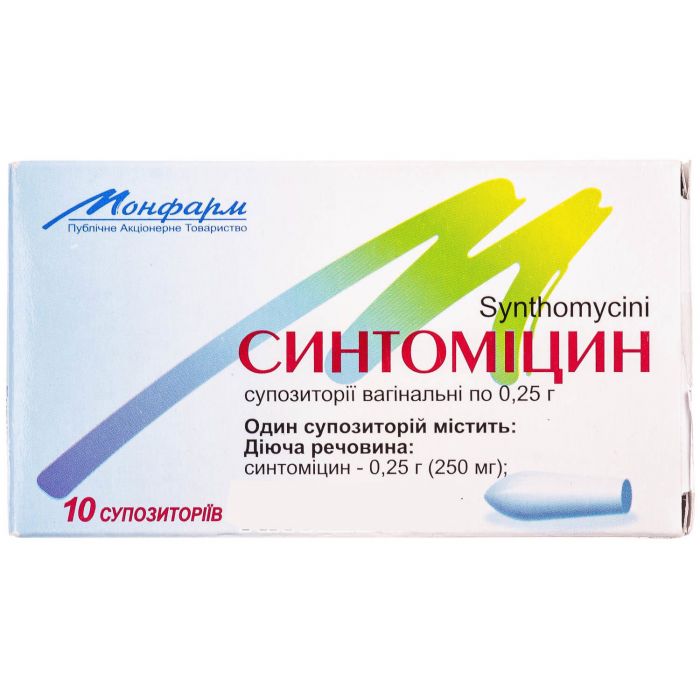контрактне виробництво
свічки контактне виробництво
виробництво торгова марка
Synthomycin

Release form
Vaginal suppositories.
For children
Not used
For pregnant women
Not used
For nursing mothers
Not used
For drivers
Not specified
Storage temperature
to 25 °C
INSTRUCTION
storage
active substance: chloramphenicol; 1 suppository contains synthomycin 250 mg (0.25 g); excipient: solid fat.
Medicinal form
Vaginal suppositories. The main physicochemical properties: suppositories are white or white with a yellowish or creamy shade of color.
Pharmacotherapeutic group
Antimicrobial and antiseptic agents used in gynecology. Antibiotics. ATX code G01A A05.
Pharmacological properties
Pharmacodynamics. The active substance of the drug is chloramphenicol - a broad-spectrum antibiotic that has high antibacterial activity against pathogens of various forms of purulent-inflammatory processes. Chloramphenicol is a bacteriostatic antibiotic, it disrupts the process of protein synthesis in the microbial cell (having good lipophilicity, it penetrates the bacterial cell membrane and reversibly binds to the 50S subunit of bacterial ribosomes, as a result, the transfer of amino acids to growing peptide chains is delayed, which leads to a violation protein synthesis). Active against most strains of gram-positive and gram-negative microorganisms, pathogens of purulent, intestinal infections, meningococcal infection: Escherichia coli, Shigella dysenteria, Shigella flexneri, Shigella boydii spp., Shigella sonnei, Salmonella spp. (including Salmonella typhi, Salmonella paratyphi), Staphylococcus spp., Streptococcus spp., (including Streptococcus pneumoniae), Neisseria meningitidis, Neuseria gonorrhoeae, some strains of Proteus spp., Burkholderia pseudomallei, Rickettsia spp., Treponema spp., Leptospira spp., Chlamydia spp., (including Chlamydia trachomatis), Coxiella burnetii, Ehrlichia canis, Bacteroides fragilis, Klebsiella pneumoniae, Hemophilus influenzae. Has no effect on acid-resistant bacteria (including Mycobacterium tuberculosis), anaerobes, methicillin-resistant strains of staphylococci, Acinetobacter, Enterobacter, Serratia marcescens, indole-positive strains of Proteus shh., Preudomonas aeruginosa spp., protozoa, fungi. Resistance of microorganisms to chloramphenicol develops slowly. Pharmacokinetics. Acts locally, penetrates well into the tissues of the uterus. The half-life is 3–5 hours. Excreted with urine unchanged and in the form of metabolites, partially excreted with feces.
Indication
Bacterial gynecological infections (vaginitis, cervicitis) caused by microorganisms sensitive to synthomycin. For the prevention of purulent-inflammatory diseases in gynecology; before invasive procedures: abortions, gynecological operations (diathermocoagulation of the cervix, hysterography), before and after the installation of an intrauterine spiral.
Contraindication
• Hypersensitivity to the components of the medicinal product. • Allergy and toxic reaction (dyspeptic phenomena, dysbacteriosis, mental disorders) to chloramphenicol in the anamnesis. • Psoriasis. • Eczema. • Fungal diseases of the vagina. • Suppression of bone marrow hematopoiesis.
Interaction with other medicinal products and other forms of interaction
the use of the drug with erythromycin, oleandomycin, nystatin and levorin increases antibacterial activity, and with benzylpenicillin salts, it decreases. The drug is incompatible with diphenyl, barbiturates and ethanol. It should not be prescribed simultaneously with drugs that inhibit hematopoiesis (sulfanilamides, pyrazolone derivatives, cytostatics).
Features of use
With long-term use, genital candidiasis develops. In the course of treatment, systematic control of the composition of peripheral blood is necessary; in the event of leukopenia, the drug must be discontinued. Use during pregnancy or breastfeeding. Do not use during pregnancy or breastfeeding. The ability to influence the speed of reaction when driving vehicles or other mechanisms. Tests to study the effect of suppositories on the ability to drive vehicles and other mechanisms were not conducted.
Methods of application
Apply to adult women. Having previously released the suppository from the contour shell, insert it as deeply as possible into the vagina. The patient should lie on her back. Apply 1 suppository 2-3 times a day. The maximum daily dose is 4 suppositories. The course of treatment is 5–7 days. Children. Do not use the drug for children.
Overdose
Symptoms: it is possible to increase the side effects of the drug. Treatment: symptomatic.
Side effects
On the part of the hematopoietic system: leukopenia, thrombocytopenia, reticulocytopenia, a decrease in the level of hemoglobin in the blood. From the side of the immune system: allergic reactions are possible, including: Quincke's edema, other signs of irritation that were not noted before treatment, skin rashes, itching, burning sensation, hyperemia, swelling. From the gastrointestinal tract: dyspeptic phenomena (nausea, vomiting, loose stools). In these cases, the use of the drug should be stopped.
Expiration date
2 years.
Storage conditions
Store in the original packaging at a temperature not higher than 25 ºС. Keep out of the reach of children.
Packaging
5 suppositories in strips. 2 strips in a cardboard pack.
Leave category
By prescription.
Producer
Monfarm PJSC.
Address
Ukraine, 19161, Cherkasy region, Uman district, village Avramivka, str. Zavodska, 8.
